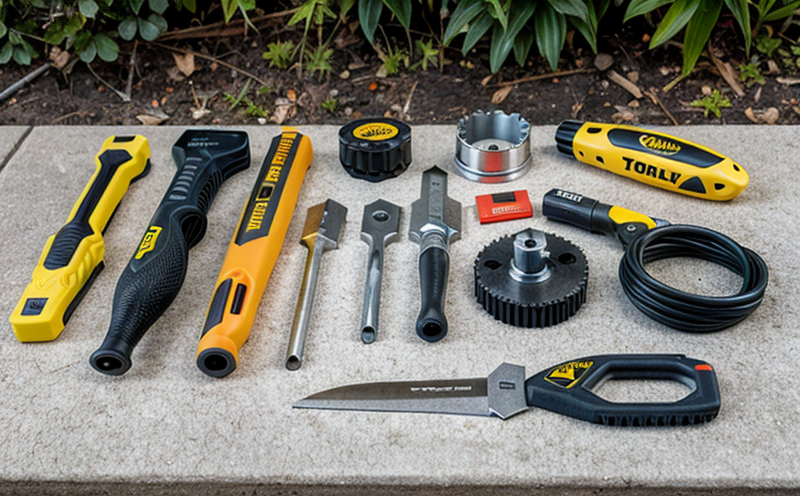Fatigue Resistance Testing of Hinges
In the realm of consumer products and product safety testing, particularly within the DIY tools and hardware sector, fatigue resistance testing is a critical component. Fatigue resistance testing ensures that hinges can withstand repeated loads over extended periods without failure. This service is pivotal for quality managers, compliance officers, R&D engineers, and procurement teams aiming to ensure product reliability and longevity.
When selecting hinges for DIY tools or any hardware application, the focus is on durability under cyclic loading conditions. Fatigue resistance testing evaluates how well a hinge can endure repeated stress cycles until it either fails or meets predetermined criteria. This ensures that products not only meet initial performance standards but also maintain their integrity over time and usage.
The process involves several key steps: specimen preparation, calibration of the test machine, application of cyclic loading, monitoring for signs of fatigue failure, and recording data throughout the testing process. Specimens are typically subjected to specific load cycles that simulate real-world use conditions. The goal is to determine at what point a hinge begins to show signs of wear or structural integrity issues.
Using advanced testing machines capable of applying controlled cyclic loads allows for precise measurement and control over test parameters. This ensures accurate results that can be used to make informed decisions about product design improvements and material choices. Compliance with international standards such as ISO 1924-3:2021 (Mechanical properties of fasteners - Fatigue testing of fasteners - Part 3: Fasteners other than nuts and bolts) is essential for ensuring that tests are conducted in a consistent and repeatable manner.
One critical aspect of this service is the ability to provide detailed reports summarizing test results. These reports include information on the type of hinge tested, the load conditions applied during testing, any observed deformations or failures, and recommendations for potential improvements based on these findings. Reporting helps manufacturers understand where their products stand compared to industry benchmarks and identify areas for enhancement.
Understanding why fatigue resistance testing is important extends beyond just ensuring compliance with regulations; it also plays a vital role in enhancing customer satisfaction by delivering reliable, long-lasting products that meet or exceed expectations. By investing in this type of comprehensive evaluation early on in the product development process, companies can avoid costly recalls later down the line while maintaining their reputation for quality.
| Application Area | Description |
|---|---|
| Durable Furniture Design | Ensures hinges used in furniture can withstand frequent opening and closing without failing. |
| Safeguarding Consumer Products | Helps prevent accidents caused by hinge failure leading to product recalls or safety issues. |
| Enhancing Product Lifespan | Aids in creating more robust products that last longer, reducing waste and environmental impact. |
Scope and Methodology
The scope of fatigue resistance testing for hinges encompasses a range of parameters designed to simulate realistic operating conditions. These include the type of hinge being tested, the material composition, expected load cycles, and environmental factors such as temperature variations that may influence performance.
- Specimens are typically selected based on their intended use within specific product categories (e.g., door hinges for cabinets).
- The testing machines used must be capable of applying controlled cyclic loads with precise control over amplitude and frequency.
- Data collection includes measurements of deflection, stress-strain relationships, and any changes in the hinge's geometry during each loading cycle.
Methodologically speaking, this involves preparing specimens according to standard procedures outlined by relevant international standards. Calibration ensures that all equipment is operating correctly before testing begins. Once calibrated, cyclic loading starts at specified intervals until failure occurs or predetermined criteria are met.
Industry Applications
- Incorporating hinges into furniture designs where frequent opening and closing is common, such as doors and drawers.
- Implementing safety features in consumer products to prevent injuries due to hinge failure.
- Promoting sustainability by extending the lifespan of hardware components through robust design practices.
Use Cases and Application Examples
- Durable furniture manufacturing: Ensuring that hinges used in high-use areas like kitchen cabinets can handle daily opening and closing without damage.
- Home improvement projects: Providing assurance that newly installed hardware will perform reliably over time, enhancing overall project quality.
- Product recalls prevention: Detecting potential weak points early on so manufacturers can address them proactively before issues arise in the market.





